UNCLE MEAT: INTEGRATION
After "Lumpy Gravy", Zappa further consolidated his intentions to combine pop music with modern music and jazz on "Uncle Meat".
This double album is imbued with an abundance of ideas, to which Zappa could keep returning. "Pound for a brown" (see the Zappa's teens sections)
and "King Kong" became concert favorites. "Uncle Meat" and "Dog breath" returned in a version for small orchestra
that can be found on the 1993 CD "The Yellow shark". There are some live-recorded sections on the album and a few comic
pieces of conversation.
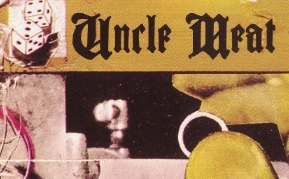 "Uncle Meat" was recorded between October 1967 and February 1968, but released a year later in
April 1969. The delay was due to Zappa's intent to have it accompanied by a movie of the
same name. Several
scenes were filmed, but there weren't enough funds to finish it
and eventually some band members wouldn't take part in it no more if they didn't get paid for it. Ultimately
Zappa gave it up, only to return to the footage in the eighties. To the right part of the album's cover art
with "Uncle Meat" in ancient German letters. It doesn't carry the name of The Mothers or Zappa, but it does list
the members of The Mothers at that time in the CD booklet.
"Uncle Meat" was recorded between October 1967 and February 1968, but released a year later in
April 1969. The delay was due to Zappa's intent to have it accompanied by a movie of the
same name. Several
scenes were filmed, but there weren't enough funds to finish it
and eventually some band members wouldn't take part in it no more if they didn't get paid for it. Ultimately
Zappa gave it up, only to return to the footage in the eighties. To the right part of the album's cover art
with "Uncle Meat" in ancient German letters. It doesn't carry the name of The Mothers or Zappa, but it does list
the members of The Mothers at that time in the CD booklet.
1.1 Uncle Meat (main title theme)
The "Uncle Meat main title theme" can be divided in three sections.
1) The first section is a melody that uses the notes of D with C sharp as the melodic centre.
Uncle Meat theme, opening (midi file).
Uncle Meat theme, 1st section and opening of the 2nd section (notes).
The melody derives its modern music character from the fact that it follows no traditional chords and its structure
is determined by intervals and repeating figures, like fourths in the first bar, seconds in the second bar and a
repeated figure with a fifth in the third and fourth bar. We'll see some more of interval determined structures in
the next section at "Piano introduction to Little House I used to live in". The melody moves several times towards the centre note C sharp.
The opening of "Uncle Meat" is one of a series of examples in this study where Zappa creates harmonic fields by freely mixing
as good as all notes of a scale. There's a D pedal note, determining the scale to be D, with the Dsus4 chord played
over it in staff 2. The melody in staff 1 follows the VI 11th chord in a broken form. Staff 3 plays through the scale
in sort of a counterpoint way. You can hear all notes of D except for C#: that one turns up as the central note of bar 2.
2) The second section follows the E flat scale, filling in the notes that were left out by the D scale of the first part
(bars 7-10 of the above note example). Contrary to the first section, in this part normal 5th and 7th chords can be recognized
as it comes to the lead melody. It's following a 5th chord on C and a 5th chord on B flat (only the third). Staff two contains
a steady Ebsus2 chord.
3) The third section of the main title theme is multi-scale oriented. During seventeen bars several scales alternate
each other after each bar with a descending and later on ascending line in the bass as counterpoint. No note has any key
function, but when the bass notes in the next example are taken as keynotes, the keys could be called C, B flat, A Minor
(Aeolian) and A flat Lydian. We can also here see examples of that the fourths movement, with which the piece has begun, returns
in different appearances. When you look at the complete score in the Songbook, you'll notice several other instances of such
fourths movements. You'll also see sequence building in this third section.
Uncle Meat theme, bars from the third block (notes).
Though the "Uncle Meat main title theme" is a short piece, it contains a lot of different technical means, using
opposition as well as variation as structure building methods. The return of the theme during the "Uncle Meat variations" is
welcome. Here it has a specific intro and outro added to the main theme. The variations are formed by playing
the theme a couple of times in different settings. The instrumentation varies, the pitches lie at different positions
and the melody is played in several parallels.
Continued below at track 11.


Part of the Uncle Meat theme in Zappa's handwriting (CD booklet) and a copy of it from the recording sessions (outtake of a photo from the
Michael Ochs archives). The notes from this copy aren't in Zappa's handwriting, but the lyrics are, showing that at one point Zappa
considered having Uncle Meat lyrics ("I got 'em at the Pep Boys, at the Pep Boys monday. Fuzzy dice and bongos ...").
1.2 The voice of cheese
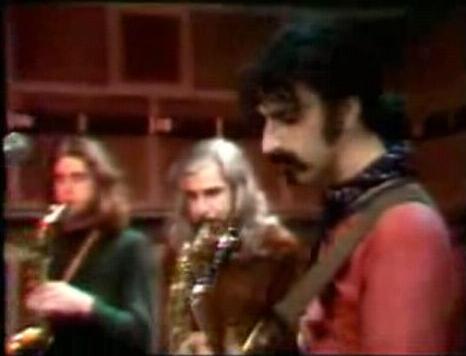 On "Uncle Meat" Zappa included three smaller tracks with monologues. Two feature Pamela Zarubica once more
as the Suzie Creamcheese character. I'm following the track lists, but since this study is about Zappa's music,
I'll mostly skip commenting upon a track when there's no music in it. The same goes for covers. For the conceptual idea
of an album, however, these tracks are of importance.
On "Uncle Meat" Zappa included three smaller tracks with monologues. Two feature Pamela Zarubica once more
as the Suzie Creamcheese character. I'm following the track lists, but since this study is about Zappa's music,
I'll mostly skip commenting upon a track when there's no music in it. The same goes for covers. For the conceptual idea
of an album, however, these tracks are of importance.
Image to the right: The Mothers playing "King Kong" during their 1968 BBC Television special.
1.3 Nine types of industrial pollution
"Nine types of industrial pollution" is the first time when Zappa took
a solo by himself as a separate composition. It's a sped up track, as the ZFT release "Uncle light" shows.
"Uncle light" belongs to the project/object series by the ZFT with additional recordings surrounding an album.
This time it's the original vinyl mix, the tracks in an earlier following order and a couple of different edits.
"Nine types of industrial pollution" lasts 9:53 minutes on this release, thus much longer than the 5:56 minutes
on "Uncle Meat". It's something Zappa frequently did. This solo is in Bb Dorian, with Bb as bass pedal note.
Nine types of industrial pollution, 4:22-4:36 (midi file).
Nine types of industrial pollution, 4:22-4:36 (transcription).
This solo is actually a guitar duet. With nobody else being credited for playing guitar, he must have overdubbed a second guitar
part. Probably a third one too for some additional harmony notes. It's also a rare instance of him playing acoustic guitar. The drums-percussion element during this solo is abundant.
Four people could have participated in playing that part. At some points the bass part isn't brightly audible, the transcription being an approximation.
Though lasting only 14 seconds, the example above already takes up quite some space. If you would write
out the drums-percussion part too, it would double in size. It's quite a dense solo.
1.4 Zolar Czakl
On the album liner notes Zappa is talking about recording layer over layer and electronically
mutating the sound of acoustic instruments.
Zolar Czakl, opening (midi file).
Zolar Czakl, opening (transcription).
This is what's done quite extensively in "Zolar Czakl". It's an even shorter piece than "Uncle Meat", but thus dense that
it could take you hours to know what exactly is going on in it. It's atonal music with varying meters, counterpoint and harmonies.
1.5 Dog breath, in the year of the plague - Blood unit
Zappa has often addressed to his work as one big project, where the individual albums are related to each other by a conceptual
continuity. There is a basic truth in this for three main reasons. First his attitude towards his music never changed. He could
integrate all style elements in his output, whatever sounded nice to him for whatever reason. He did this like this on "Absolutely free"
in 1967 and still did this on "Civilization phaze III" in 1993. Secondly he never took a distance from earlier work later on in his career.
There's a high degree of consistency in his musical output and the repertoire he played live. Thirdly he frequently
returned to themes he had used before, mostly in the form of live variants. This
he referred to with his expression "the crux of the biscuit is the apostrophe" on "Apostrophe (')".
In this third sense "Uncle Meat" can be considered a central album, possibly the album with most crumbs landing on other
albums. The next section is about the five appearances of "Dog breath/The dog breath variations", that give a good idea of how he could vary
a theme at different points in his career. The capitals refer to the various themes that show up in the different pieces. The presence
of B ("Dog breath") or D ("Dog breath variations") is the common element.
Dog breath (1969), section (midi file).
Dog breath (1969), section (transcription).
1) Dog breath, 1969
In its first appearance on album as track 5 on the "Uncle Meat" CD, the main "Dog breath" theme gets incorporated in a song
with three sections. The introduction, some pop music in 4/4, is followed by the main theme, also in regular 4/4. The pitches
of the voices are in strange high registers, probably achieved by speeding a track up to double frequency. The theme is segued
by a peculiar part with modern music. It starts with fast high clavichord notes and a piano chord, played at a low
volume over a steady drum beat. Over these figures various wind instruments play short phrases, responding to each with pauses
between them. The transcription below presents the last bars of the main theme and the opening of the modern section.
Bars 1-4 have something of both G Lydian and A Mixolydian. As in the opening of "Dog breath"
the bass makes a G-A alternation, so that's G Lydian. But with the A in a lower register and longer sustained, the A gets to sound more as the key note.
The modern music section is atonal, though starting at 3:30, some diatonic material can be heard as well. It sounds as an add-in, appearing on the ZFT archive release "Meat light" as an individual track in a different edit,
introduced as "The unbelievable Blood unit". The example below contains 10 seconds from this block, lasting one and a half minute in total. By itself it looks
quite irregular. When you're listening to the whole, you can recognize the melodic elements in it, that get varied upon. Such elements are the arpeggio-like figure
from bar 12 and the melodic cell D-C-D, that appears four times in bars 13-15. This cell returns in the shape of a little sequence, starting at 2:50.
Arpeggio-like figures can be heard at other spots too, like at 2:55.
A: Pop introduction.
B: Dog breath main theme.
C: Modern atonal section.
Blood unit, opening (midi file).
Blood unit, opening (transcription).
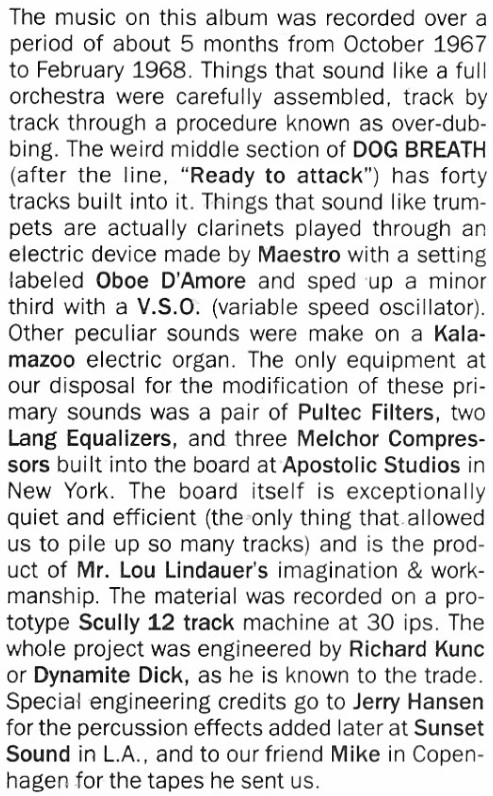 To the right the comment from the CD liner notes about recording "Blood unit" (calling it "the weird middle section"). Today you've got many people listening through
Youtube or Spotify, missing information like this.
By comparing "Blood unit" with bars 9-15 from the above "Dog breath" example, you can notice that the band recorded more tracks for block C than actually used:
To the right the comment from the CD liner notes about recording "Blood unit" (calling it "the weird middle section"). Today you've got many people listening through
Youtube or Spotify, missing information like this.
By comparing "Blood unit" with bars 9-15 from the above "Dog breath" example, you can notice that the band recorded more tracks for block C than actually used:
- Bars in 3/4: the rhythm in both recordings is the same, but the notes are pretty different. It's played on a harpsichord. In "Blood unit" it's a series of parallel
fourths. On "Dog breath" you've got fourths and minor thirds alternating. This figure continues during beat one of the first 4/4 bar. Next you can hear by the ticking
of notes that it continues during this bar in some form, but not loud enough to distinguish the notes once the other instruments start. You'd need to listen to the mastertape
to be sure what's going on. This goes for both edits. "Dog breath" knows a drum part and a dissonant bass chord during the 3/4 bars. So it looks like
"Blood unit" is an earlier phase of block C.
- First bar in 4/4: "Dog breath" is transposed a minor second down, compared to "Blood unit". Staff 3 from "Blood unit" is not present on "Dog breath".
Instead a high G can be faintly heard, as well some vague bass notes that come out more clearly in the next bar. The dissonant on beat 3 from "Blood unit", staff 5,
isn't audible on "Dog breath". The "Blood unit" example goes from 0:02 to 0:12, while the corresponding "Dog breath" section goes from 2:30 to 2:41, just a fraction slower
due to the transposition.
- Second bar in 4/4: on both edits you can hear a similar bass motion. The notes involved sound different. Staff 4 is alike in both versions, though not all notes from
"Dog breath" are audible during "Blood unit". The Bb from "Blood unit", beat 3, on the other hand, isn't present on "Dog breath". Possibly staff 4 is a combination of two tracks.
- Third bar in 4/4: largely identical, apart from the minor second transposition. Staff one goes a bit differently and sounds like being played on different instruments.
Continued below at track 8 with appearances 2)-5).
1.6 The legend of the golden arches
"Pound for a brown/Legend of the golden arches" goes back to Zappa's youth.
Originally he wrote this piece as a movement of a string quartet. There are many versions of this title. The specific "Uncle Meat" version
exists as an orchestra arrangement by Robert Peate, authorized by Munchkin Music (Michael Peyton sent me a copy). The general set-up of this piece is:
0:00 Intro, going similar to the "Foamy soaky" example from my Lumpy gravy section, bars 4-7.
0:08 Main theme (see the Lost episodes section of this study).
0:58 Second block. At this point the key becomes G# Dorian. While Robert maintains the presets of the B Mixolydian key from the beginning,
during this section the score involves an A# and an E#. Characteristic is the irregular G#-D# alternation for the accompaniment, over which
a number of melodies are played. The harp/piano/celeste part can get pretty dissonant with the other parts, to be played lightly
in the background.
The legend of the golden arches, 1:13-1:29 (midi file).
The legend of the golden arches, 1:13-1:29 (orchestral arr.).
1:33 Part of the main theme returns, being varied upon.
1:54 Third block, that you might call another form of "Uncle Meat" variations. The first motif from the main title theme re-appears frequently, being
led through varying keys. The example below contains three instances:
- Bar 1: the motif in a 7/4 meter.
- Bar 2: repeats, but now other melodic lines enter the picture.
- Bar 3: while these lines continue, the motif returns once more in the shape of a variation.
These melodic lines continue without following a specific meter or scale (some notes keep being altered). It's a rather free
through-composed section. The meters in the example below are my notational choice, other notations are very well possible.
The legend of the golden arches, 1:54-2:22 (midi file).
The legend of the golden arches, 1:54-2:22 (transcription).
The example above avoids the minor second in the harmonies till the end: on top of an E (major triad) chord the combination
Ab(G#)-Eb-G is getting played, though with a large interval distance between these two chords.
3:15 Suzie Creamcheese: "The first thing that attracted me to the Mothers ..."
3:27 End.
This title returns once more on "Uncle Meat" in a different set-up as "A pound for a brown on the bus". See below at track 15.
1.7 Louie Louie
"Louie Louie" is a live recording from the Royal Albert hall, featuring sax improvisations and Don Preston briefly
playing the pipe organ in the hall with the progression from "Louie Louie". It's a reference to Richard Berry's hitsingle, something Zappa
used as a gimmick throughout his career. See also "Plastic people" from the Absolutely free section.
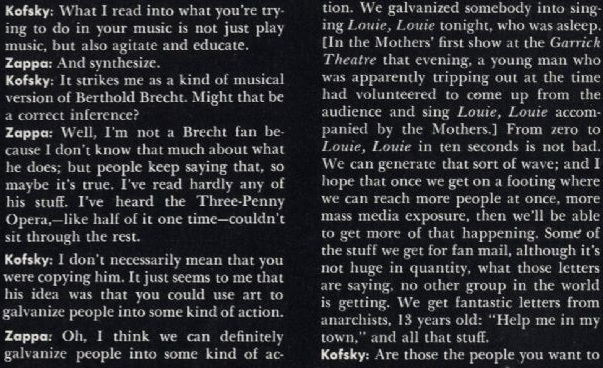
Zappa being interviewed by Frank Kofsky for the Jazz & Pop magazine, september 1967, about "Louie Louie" being part
of the Mothers of Invention folklore at the time they played at the Garrick Theatre.
1.8 The dog breath variations
Continuation of above, track 5. Track 8 is the "The dog breath variations", with its theme being presented above at track 5, appearance 1).
Here I'm continuing with appearances 2)-5).
2) The dog breath variations, 1969
"Dog breath" returns on "Uncle Meat" in track 9 with variations. The opening starts with the theme
as presented below in a rhythmical variation. Instead of a continuing a 4/4 set up, the meters are here changing frequently. During the
first half the accompaniment is predominantly dealing with harmonies, whereas in the second half a counterpoint movement
is taking over the upper hand. The melody is made up of a series of phrases, with each phrase reacting to the previous one by
taking over some of its characteristics. In classical music they call this type of variations character variations as opposed to variations
that keep varying a whole theme. The example below just shows the two opening variations upon the whole theme and the beginning
of a new phrase. This version starts with the Em7 chord and with the E as root note for the opening bars, its basis has become
E Dorian.
D: Dog breath variations #1.
The dog breath variations (1969), opening (midi file).
The dog breath variations (1969), opening (transcription).
3) Dog breath, 1971
The 1971 version on "Just another band from L.A." begins with a repeated rock riff, before the original theme returns. This
riff can already be recognized as one of the motifs in the accompaniment in both "Uncle Meat" versions (the bass line
at the beginning of the above "Dog breath" version; on "Dog breath variations" it's played halfway by the acoustic guitar).
Here Zappa is using the individual voices of
Flo and Eddie to make some divergence between them for the "fuzzy dice ..." line, as shown in the transcription Wolfgang
Ludwig made of this particular execution (see "Dog breath (1971)"
from the Just another band from L.A. section).
The closing with the "hear my plea" section is here far more extended, including
a guitar solo as part of the outro.
E: Rock introduction.
B: Dog breath main theme.
F: Outro with guitar solo.
4) The dog breath variations, 1974
The two 1974 versions, available on "YCDTOSA II" and "The dub room special", were recorded shortly after each other and
only differ in instrumentation. For transcribing I used the "Dub room special" track. The 1971 opening riff is used again, but now followed by the "Dog breath variations".
This version distinguishes itself from the one on "Uncle Meat" by that the accompaniment isn't adding harmonies, but
immediately starts off with a counterpoint line. It remains two part counterpoint all through. Regarding style the bass
has something of an improvised "walking" bass in jazz compositions. It's prescribed here because it goes exactly the same
on both 1974 executions, and also because it partly overlaps with the 1969 "Dog breath variations" bass line.
E: Rock introduction.
D: Dog breath variations #2.
The dog breath variations (1974), opening (midi file).
The dog breath variations (1974), opening (transcription).
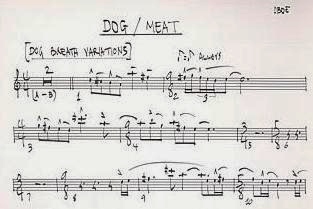
An unreleased version of the "Dog breath variations" is part of the "Dog/Meat" combination Zappa orchestrated in the seventies
for the Wazoo and Orchestral favorites ensembles. Presented above is the opening of the oboe part, auctioned on internet,
spring 2010. By the meter division you can see that this arrangement suggests to some extent that it's different from the other examples shown here.
At some points you can say it's a notational choice. At bars 3-4 however you get 4/4 followed by 9/8 with a bow for the lead melody.
This implies that some of the other parts must be doing something in 9/8 here, which is not the case on "Uncle Meat". Otherwise
this division would have no purpose. You can compare it with the drum part from below, where the drummer is clearly indicating the meters.
The oboe part is the only element of the score I've encountered, so I can't say how this version would sound.
5) Dog breath variations, 1993
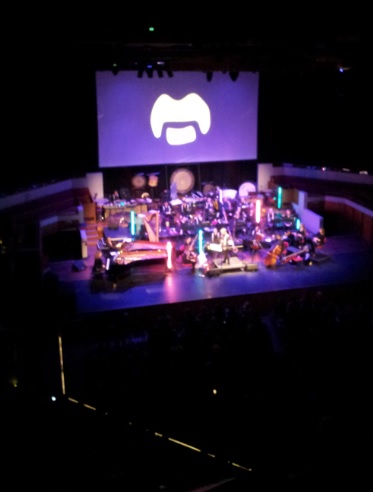 For the Ensemble Modern Zappa wrote a score that begins quite mysteriously with two odd numbered meters alternating each
other (9/8 plus 11/8). These two bars are next used as a vamp for the slow introduction of the main theme. The hereupon following variation returns
to the normal tempo of the original versions. The opening gets commented upon in an article by Barend
Tromp in the Dutch magazine "Mens en melodie" (People and melodies), June 2000, where it is presented as an example
of mixing elements from (modern) classical music (the odd rhythm), pop and jazz (the pulse of 8th notes).
For the Ensemble Modern Zappa wrote a score that begins quite mysteriously with two odd numbered meters alternating each
other (9/8 plus 11/8). These two bars are next used as a vamp for the slow introduction of the main theme. The hereupon following variation returns
to the normal tempo of the original versions. The opening gets commented upon in an article by Barend
Tromp in the Dutch magazine "Mens en melodie" (People and melodies), June 2000, where it is presented as an example
of mixing elements from (modern) classical music (the odd rhythm), pop and jazz (the pulse of 8th notes).
G: Modern intro.
D: Dog breath variations #3.
Dog breath variations (1993), opening (midi file).
Dog breath variations (1993), opening (notes).
This 1993 version begins with a vamp like figure of two bars in 9/8 plus 11/8. Its meters division is thus completely new compared to the previous versions.
The basic time unit of a quarter note becomes a dotted quarter note. Apart from that the tempo is also slower, thus the whole becomes extra slow compared to previous versions.
But when the melody has arrived at the 3/4 bar, 16th notes are used, causing an acceleration to the tempo of the earlier version.
The notes of the vamp mainly form the chord E-B-F#-G, with occasionally an A or C# added to it.
During the bars in which the vamp is used, Zappa has harmonized the lead melody as a series 5th chords.
The combinations with the notes of the vamp make the harmony of the whole very free, mixing all notes of the E Dorian scale
at will. In my example I'm notating what I can hear on the CD, with the score from "Mens en melodie" as starting point.
I might be hearing a few details not 100% correctly, but, as about always, some minor adaptations where made on the spot.
In 2022 I got a chance to look at the entire "Dog breath variations" score as used by the Ensemble Modern, with another example
being present in the Yellow shark section of this study. I've added bars 1-4 of this score below the example. An adaptation that apparently
was made during repetitions is the end of bar 1 for horn 2. It's notated in the score as F#-F#-E, but I'm hearing E-pause-F#.
To the right the Ensemble Insomnio performing the Yellow shark (Vredenburg, Utrecht, 2-9-2019).
"The dog breath variations" was the concert opener as well as used for an encore.

In 2021 I encountered the drum part from "The dog breath variations". It's dated as 1970, already including the intro, that is alternating 9/8 and 11/8.
1.9 Sleeping in a jar
"Sleeping in a jar" is the second movement of the above mentioned quartet. Both
movements are included in the Zappa's teens section of this study. Next to the version on "Uncle meat", you can find other renditions on:
- "Road tapes, venue #1": live, in combination with "Pound for a brown".
- "Ahead of their time": idem, briefly described in the Zappa's teens section.
- "Road tapes, venue #3": idem, from the Flo and Eddie era.
- "Carnegie hall": idem.
- "Playground psychotics": idem, now released as an individual track.
So live the two movements were played in combination during 1968-1971, with "Sleeping in a jar" being played as an instrumental. "Playground psychotics" is a compilation with Zappa picking tracks from three different concerts.
On the ZFT release "Meat light" you can find a track actually using the title "The string quartet", being an alternative recording of "The legend of the golden arches".
It's without "Sleeping in a jar". It would be interesting if ever the original score of both movements would turn up, to see how Zappa originally composed the
two movements as a teenager. In "Pound for a brown" the melodic lines of a quartet set-up can be recognized. "Sleeping in a jar" gives no clues how he originally
had instrumentated this song. On the "Uncle meat" album the arrangement is pop-music like (except for the outro), moving away from the modern character of most tracks from above.
1.10 Our bizarre relationship
"Our bizarre relationship" is Suzie Creamcheese once more. It begins with her telling about an episode at Zappa's house you might indeed call bizarre: "No one could ever understand our bizarre relationship because I was your intellectual frigid housekeeper. Especially when you'd be going to bed with one chick at night and I wake up in the morning and find another one there, screaming at me, heh, asked me what the fuck that chick was doing in your bed and I'd walk in and you weren't with the same one you were with the night before. Oh, I'll never forget that, as long as I live."
1.11 The Uncle Meat variations - Exercise #4 (1973)
Continuation of above, track 1.
Track 11 features the "Uncle Meat variations", being variations upon the material from track 1.
The later "Exercise #4 (1992)" from the Yellow shark section of this study appears as an intro for these variations
on "Uncle Meat".
The section below starts with seven bars from the third section where the bass and descant
are mirrored compared to the "Uncle Meat main title theme". The theme is now played in a lower register and the chords
are played via the descant part. After these bars part one of the theme returns, now sung by high vocals. Especially
the soprano voice by Nelcy Walker is touching. Notable is the percussion part here. After ticking the beat in straightforward
3/4, the percussion starts playing in 2/4 when the main theme enters again, causing a mild form of polyrhythms. All beats
are executed on a tom with C as pitch (the key here then being C Mixolydian for part one of the theme, with the theme being
transposed a minor third up). The accentuated notes
from bar 8 onwards indicate the downbeat by the percussion, played by the cymbal as well, while I've notated the melody in 3/4 as above
during the main title theme.
The Uncle Meat variations, section (midi file).
The Uncle Meat variations, section (notes).
When one would like to study the variations upon "Uncle Meat" Zappa wrote, one should not only consider the "Uncle Meat variations" itself, but
also other and later appearances of this title:
- Its return during the second half of "The legend of the golden arches", track 6 above.
- The experiment with playing it against "King Kong" during "Uncle rhebus". See below at the bottom of this section.
- "Exercise #4" as played on "Road tapes, venue #2". The first minute of this specific version contains melodic variations upon
material from "Uncle Meat", before "Exercise #4" starts as we know it from "The yellow shark". See below.
- "Uncle Meat" would next re-appear being played live during the 1973-4 tours, present on "YCTDOSA Vol. II" and the ZFT releases
"The dub room special", "Road tapes, venue #2" and the "Roxy performances".
- "Uncle Meat (1992)" would re-appear again in 1992, being played by the Ensemble Modern. Like in 1973-4 it has its
tonic for theme one repositioned from D to G, becoming G Lydian. So you can hear this theme in all three major-type of scales on Zappa's albums. See the Yellow shark
section from this study for further comments upon this title.
The ZFT further released the following two titles from their archive on "Uncle light":
- "Exercise 4 variant" with at some points some more variations.
- "Uncle Meat (Live at Columbia University 1969)", played live as on "Uncle Meat" before the album was out on the market.
It has a 15 seconds coda of its own.
Exercise #4 (1973), 0:00-0:30 (midi file).
Exercise #4 (1973), 0:00-0:30 (notes).
When studying Zappa's music for variations one has to bear in mind that variations are not only happening during an individual performance
of a piece. Maybe more importantly, they are happening by comparing different versions over time. In the YCDTOSA II section of this study
I've included a list of examples of version differences, coming by in this study. "Strictly genteel" can be seen as the most
classical form of variations within one piece (see the L.S.O. section for the details). In case of the above listed "Uncle Meat"
appearances, the ones carrying "Uncle Meat" in their title always leave the main title theme intact. It can get transposed and
instrumentated anew, different accompanying figures can get introduced, but the theme, as represented in the "Uncle Meat" CD booklet
remains the same. The more drastic differences are new intros and outros, only indirectly or not at all being related to the main theme.
Zappa did vary the main theme itself in versions carrying different titles. Its re-appearance during "The legend of the golden arches"
can be seen as character variations: some elements from theme one return repeatedly, but not the complete theme. "Exercise #4" (1973) does
know two variations upon theme one in its entirety. The correspondence of the bars from "Uncle Meat" and the example from above are shown in the
table below. The first thing to notice is that "Exercise #4" knows varying meters, while "Uncle Meat" is in 3/4 all through.
Phrase Uncle Meat Exercise #4 (1973)
A Bar 1 Bars 1-2 in 4/4 and 2/4
B Bar 2 Bar 3 in 7/8
C Bars 3-4 Bars 4-5 in 11/8 and 7/8
D Bars 5-6 Bars 6-7 in 11/8 and 7/8
E Bar 1, repeating Bars 8-9 in 4/4 and 2/4
F Bar 2, repeating Bar 10 in 7/8
More details regarding the phrases:
- A. The bass pedal note has changed from D to A, causing a switch from D to A Mixolydian. The steady accompanying figures
from "Uncle Meat" don't return. The harmonies from "Exercise #4" are much more free, beginning with A7 in bar 1.
Bar 2 is inserted, compared to "Uncle Meat".
- B. This bar got extended from 3/4 to 7/8. The bass makes a melodic counter movement instead of remaining a pedal note.
- C. The meter division got changed. It has extra melodic notes, but the melody from "Uncle Meat" can still be recognized, sometimes repositioned.
While the descant keeps following notes from A Mixolydian, the bass and other parts are playing with or against it, using
many chromatic notes. The whole starts to sound atonal, rather than diatonic.
- D. The same idea gets applied once more. Bar 7 is evasive, not belonging to A Mixolydian anymore. It's used
for modulating to C Mixolydian, not in a standard manner.
- E. While "Uncle Meat" literally repeats theme one, "Exercise #4" begins with a transposition of bars
1-2. Bars 8-9 are now in C Mixolydian.
- F. Similar to phrase B.
The second variation of theme one lasts until 0:42. Next a large sequence of variations upon phrase A only begins, lasting till 0:58.
Only at that point "Exercise #4" begins, as we know it from the "Uncle Meat variations".
1.12 Electric Aunt Jemima
There's a pause between tracks 11 and 12, while all other tracks segue. To some degree the original "Uncle Meat" album could
be divided into two blocks:
- Tracks 1-11, "Uncle Meat" through the "Uncle Meat variations", with an accent upon modern compositions.
- Tracks 12-22 and disc II, with an accent upon jazz, improvisations and some pop songs.
The "Uncle Meat movie excerpts" got inserted with the re-release on CD. The ZFT release "Uncle light" from 2016, largely a re-issue of "Uncle Meat",
shows that Zappa once had a completely different sequence in mind regarding the tracks. At that point the songs got hustled without any attempt to group
them for their style. Perhaps the album as a whole comes out better balanced that way.
"Electric aunt Jemima" is a second more pop-like track. The lyrics however are modern poetry, reproduced in the booklet. The same goes for all the
songs from "Uncle Meat", that have lyrics (most tracks are instrumentals). They refer to actual events, but the emotions
they provoke are personal and their meaning is deliberately kept in the dark. Here it has Aunt Jemima, the cereal products brand, as a starting point.
Electric Aunt Jemima, 0:00-0:24 (midi file).
Electric Aunt Jemima, 0:00-0:24 (transcription).
The example above includes its main theme, played after a little intro of four bars. The rhythm of the first two beats can vary each bar,
caused by speech-influence. In this case you've got:
Bars 1 and 3: two quarter notes.
Bars 2 and 4: three triplets within a triplet (or a 9-tuplet).
Bars 5, 7 and 11: a triplet followed by two eighth notes.
Bars 6 and 10: triplets.
Bar 9: an eighth note, followed by two dotted eighth notes.
Bar 12: a triplet, followed by two dotted eighth notes.
Notable is the positioning of the vocal parts, very low to very high. During bars 5-12 a guitar is improvising a little in the background
along the sung melody. I've notated what I can distinguish. This song is in D with the meter being standard 4/4.
1.13 Prelude to King Kong
Improvising in odd meters belonged to the standard repertoire the Mothers had in the sixties. See the "America drinks",
"Didja get any onya?" and "Toads of the short forest" examples/comments from this study for more upon this topic.
Here the band is playing over 5/16 in the studio. The opening is composed. Two saxes are playing synchronously in staves
one and two. Staff three represents the steady bass figure from this piece, played with only some minor variations upon it.
This bass figure sets the key to F# Dorian.
Prelude to King Kong, 0:00 till 0:10 (midi file).
Prelude to King Kong, 0:00 till 0:10 (transcription).
This composed opening is made up of three phrases:
- Bars 1-9. After picking upon the E-C# combination a little melody follows, first chromatically in bars 5-6, next diatonically
during bars 7-9. At some points the brass section is playing equal with the rhythm section (like in bars 5-6), at other points they are
playing between beats (as in bars 3-4).
- Bars 10-16. Variation upon the first phrase of the King Kong theme. See below for the notes or the "Uncle Meat" CD booklet
for the lead melody of the entire theme. Harmonically it's made up of the same figures, but transposed. The bass from Eb to F# pedal and the lead melody begins
on E and C# (parallel playing) instead of Bb.
Rhythmically it goes pretty differently, with the figures being played in a 5/16 environment. The four motifs
from this figure last 3/8 in the original score (forming a little sequence). Here they've become 9/16, where
I've indicated their starting points with letters. In the original score the four notes of the motif had 2-1-1-2 as their duration relationship
(as 16th notes). Here this relationship has become 3-2-1-3. It's not played nor transcribed with a high degree of precision, the motifs
sort of float over the bass figure. The tempo is high and when you're allowing a bit of rubato, the pattern becomes clear.
The Roxy section gives an overview of examples in this study, where Zappa is using
two meters simultaneously.
- In bar 17 the transition from phrase two to three is taking place (not included in the transcription anymore). This third phrase is being played between 0:11 and 0:19.
From 0:19 onwards the band starts to improvise, repeatedly
referring to the material from the composed section.
1.14 God bless America
"God bless America" features the Mothers singing this patriotic song live at the Whiskey a go-go. It was written by Irving Berlin at the start of the 20th century. This song could also get cited during live performances of "Call any vegetable" during 1970-71, when Flo and Eddie were in the band.
1.15 A pound for a brown on the bus
"Pound for a brown" is a second alternative recording
of "Legend of the golden arches", track 6 from above, with the tracks being sped up to high registers. As also mentioned above, its main theme is included
in the Lost episodes section of this study. Zappa would keep playing "Pound for a brown" live all through his career. Though these
live versions are closer to the way the themes are played during "The legend of the golden arches", all other versions carry the
title "Pound for a brown" only.
A pound for a brown on the bus, end (midi file).
A pound for a brown on the bus, end (transcription).
The full title on "Uncle Meat" is "A pound for a brown on the bus". The example above is the end of this track with half of the main theme returning, heard between 1:11 and 1:29.
The piece switches between closely related scales. Bars 1-8 follow Bb Dorian, while the final bars three bars are in Bb Mixolydian. Specific for this version
are the closing chords, two times Bbsus4-Bb in different rhythms (bars 10-11, staff 2, played on a keyboard with a normal pitch level).
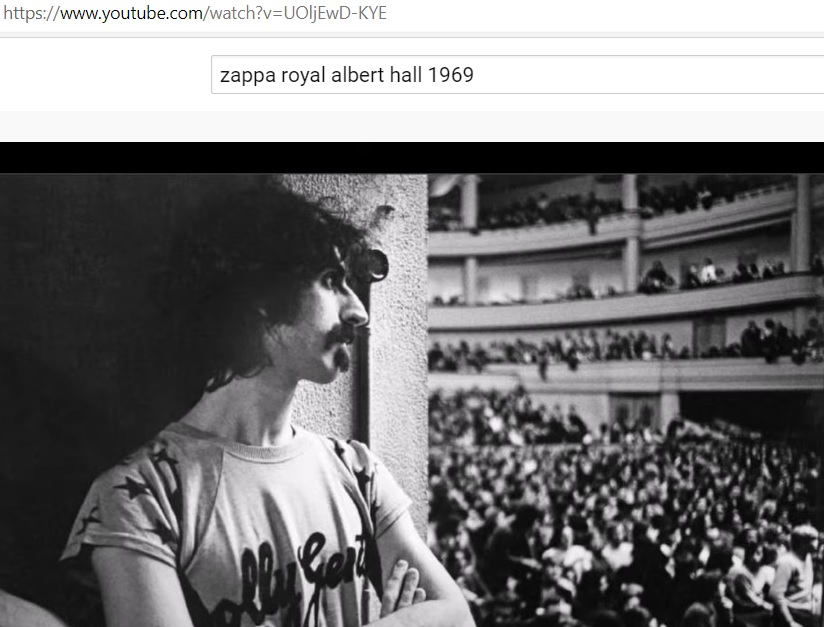
According to Zappa the title refers to a bet among the Mothers if one of them wouldn't "brown-out"
in the bus while on their way to London (Yellow Shark booklet). A brown-out normally means a fall down of the electricity, but during a bootleg recording
of the Royal Albert Hall concert from 1969, 6th of June, Zappa is explaining to the audience: "We have these surfers and they have this curious thing that they call a brown-out,
which is part of their culture. Now the brown-out is a thing that you do to impress your surfer friends and make other people's eyebrows go up and down.
And what you do is get the other people's attention, you wave at them or you say something amusing, and they turn around and look at you, and suddenly you reverse
your position and drop your pants and stick your bum out at them ... That is a brown-out ... also known as a brown and also known as mooning on the East Coast
and there uh ... there are numerous variations upon this procedure" etc. This ends with explaining with how Bunk Gardner won the bet by quickly dropping his pants
in the bus showing his butt before the window.
1.16 Ian Underwood whips it out
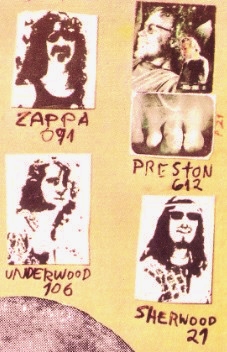 "Ian Underwood whips it out"
begins with Ian Underwood introducing himself, re-telling how he became a member of the band. To the right a small photo of him from
the CD booklet, next to Zappa, Don Preston and Euclid James ("Motorhead") Sherwood.
Zappa asked him to "whip out"
his saxophone playing and a live example from Denmark is included here:
"Ian Underwood whips it out"
begins with Ian Underwood introducing himself, re-telling how he became a member of the band. To the right a small photo of him from
the CD booklet, next to Zappa, Don Preston and Euclid James ("Motorhead") Sherwood.
Zappa asked him to "whip out"
his saxophone playing and a live example from Denmark is included here:
- 0:00 Introduction with Ian talking.
- 0:36 Sax solo begins with only the drums.
- 1:50 Other instruments are slowly coming up.
- 2:05 The bass part turns into a vamping figure and sets the key to Eb Dorian. The main accompanying harmonies
are formed by the Ab and Ebm chords, superimposed above it in an irregular manner.
Ian Underwood whips it out, 2:20 till 2:39 (midi file).
Ian Underwood whips it out, 2:20 till 2:39 (transcription).
It's another example of the drummer beating the 5/16 figure as he also did during "Prelude to King Kong". When the vamp
turns up, the dotted eighth note is taken as the downbeat note by the bass and two 5/16 figures are combined into one measure of 10/16. The total vamp
takes up two bars, alternating Eb and Ab and playing some notes in between with varying rhythms. Melodically the bass of
this vamping figure mostly follows the line Eb-Bb-Eb-Ab-Bb.
Zappa can be held responsible for creating this ambience. In the example above this element is the accompaniment, corresponding with staves two
through four. Since this track knows no composed lead melody, one might ask if Ian Underwood shouldn't have been co-credited for his solo part in staff one.
- 3:05 The bass turns into a free jazz type of playing. The harmonies can be dissonant and the atmosphere
is moving towards atonal.
- 3:51 Second vamping figure by the bass, re-installing the Eb Dorian tonality.
- 4:10 Atonal coda. The drums have stopped.
- 5:05 End.
1.17 Mr. Green Genes
"Mr. Green Genes" is the vocal version of a song that would re-appear in a more elaborate version on the "Hot rats"
album from 1969. The song knows three themes, following the patterns as described in the Hot rats and The best band
you never heard in your life sections from this study. In this latter section an example from
the "Mr. Green Genes (1988)" live version is included.
Here these themes get sung twice with in between an instrumental rendition of these themes. On "Hot rats"
this piece gets called "Son of Mr. Green Genes". The harmonic pattern of the themes is also used for accompanying
the extensive soloing during this version.

The Ludwig study is dealing with these pieces on pages 74-5 and 166. The above is from page 166, where you can see the
first theme in staff 1 with a second melody by the bass beneath it. It's a mild form of counterpoint, with both parts
being harmonically complementary.
On "Hot rats", with its intensive use of overdubbing, the harmonies
are far more complex than on the "Uncle Meat" version. It has been transcribed by Andy Aledort in the Hot rats
guitar book, where you can find these harmonies on pages 30-31. The bass line from above is played similarly
on "Hot rats", but not transcribed. As a guitar book, the bass part isn't included. During the repetitions
of the first theme another figure gets added, that Andy refers to as fill. It makes the total harmony dense,
with Zappa mingling all notes from a scale.
1.18 We can shoot you
"We can shoot you" is another example of a modern instrumental piece, atonal and partially improvised. Short as it is, it's
a collage of five sections:
- 0:00 Improvisation #1: percussion instruments.
- 0:30 Composed section #1: irregular atonal music, recorded in layers.
- 0:49 Improvisation #2: flute instruments with glissandos.
- 1:32 Improvisation #3: spoken texts. According to the Globalia.net site it has Ian and Bunk talking, ending with:
Ian: [...] and just wail out the last one.
Bunk: Mmm, let's start here, then.
Ian: Yeah.
Bunk: Three, four...
- 1:47 Composed section #2, as transcribed below.
We can shoot you, end (midi file).
We can shoot you, end (transcription).
Though only made up of four bars, quite a lot is happening. Like "Zolar Czakl" it's built up in layers with some
instruments being sped up and doubled in octaves.
- Bar 1: a sustained dissonant chord is created: B-F-A#-D# plus G#-D on beat 4, while at the end of the bar some melodic movement starts.
- Bar 2: a faster melodic string enters the picture, played in parallel major thirds.
- Bar 3: a slower melodic line via two staves with varying intervals between them. On beat 4 a flute plays an upward melody,
on album that fast, that its individual notes can hardly be discerned. The bass line on beat 4 gets played via two staves, three and
seven, playing their notes on turn with an octave between them.
- Bar 4: flute instruments play another such ultrafast figure. This section ends with a short descending melody played via an inversion of stacked fourths.
- 2:02 End.
1.19 If we'd all been living in California
Specifically during the sixties and the onset of the seventies, Zappa might record and film his group on the road or at work, often without informing them. This could sometimes go at their expense and with "If we'd all been living in California" Jimmy Carl Black is the victim. He gets credited for "poverty" as well in the CD booklet. In 1965 Zappa had promised the band members to become rich and famous if they followed him. Throughout his life, Jimmy kept complaining that only the second got fulfilled.
1.20 The air
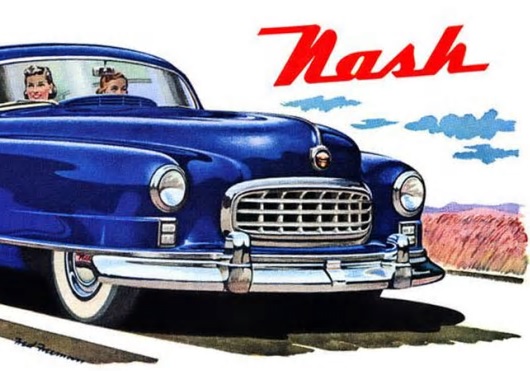 "The air" is a third relatively normal popsong from the album. "Uncle Meat" and "Cruising with Ruben and the Jets" were
recorded simultaneously. "The air" goes stylistically similar to the doo-wop songs from the latter album. Like "Electric Aunt Jemima"
it could have been included in that album just the same. It has the repeating triads in staff 3 and the doo-wop harmony singers in staves 2-3.
Only the lyrics of both these songs are in line with the "Uncle Meat"
concept, being poetic and mysterious. References to existing brands are made, like Aunt Jemima, Chevy '39 and Nash. The drawn purple car from
the CD booklet seems to be inspired by these vintage car models.
"The air" is a third relatively normal popsong from the album. "Uncle Meat" and "Cruising with Ruben and the Jets" were
recorded simultaneously. "The air" goes stylistically similar to the doo-wop songs from the latter album. Like "Electric Aunt Jemima"
it could have been included in that album just the same. It has the repeating triads in staff 3 and the doo-wop harmony singers in staves 2-3.
Only the lyrics of both these songs are in line with the "Uncle Meat"
concept, being poetic and mysterious. References to existing brands are made, like Aunt Jemima, Chevy '39 and Nash. The drawn purple car from
the CD booklet seems to be inspired by these vintage car models.
The air, end (midi file).
The air, end (transcription).
"The air" is in E with the meter being 12/8. The example above is the end with the IV and V chords alternating, ending with chanting "then I'll
crash in my Nash". Without
returning to the tonic, one might also interpret this as a modulation to A Lydian. In for instance bar 5 you can see that Zappa is using
different subdivisions of the 12/8 meter simultaneously. Below there's more about this topic at track 22.
1.21 Project X
The first half of "Project X" is a refined example of mixing diatonic and atonal material.
It begins gently in Bb with an acoustic guitar playing the Bbsus4 and Eb chords, mixed with the Bb chord beneath it in bars 2-3
(I miswrote myself in the 3rd printed version: B minor should be Bb). Bbsus4 resolving to Eb in Eb Lydian would be another
interpretation of bar 1. In the Burnt weeny you can read about the difference between the "horizontal" and "vertical" approach,
where I'm following the vertical approach (that is I consider the Bb to be the pedal note, rather than the Eb).
Over these chords the clarinet begins a sentimental melody using notes of the same scale and applying some larger interval jumps.
Bars 13-17 are the vibes and brass instruments, unleashed with rapid partly atonal partly diatonic movements. After they have
spewed their energy the guitar chords return just as quietly as they begun.
Project X, opening (midi file).
Project X, opening (transcription).
At 1:47 the second half of this title starts with music not directly related to the first half. It's atonal, a mix
of instruments with their regular sound and with mutated sounds, sometimes accompanied by pulsing chords.
1.22 Cruising for burgers (1969)
The outlines of this track go as:
- 0:00 Little intro (pick-up bar).
- 0:01 Theme 1, phrase 1, "I must be free ...".
- 0:15 Theme 1, phrase 2, "Frees me".
- 0:22 Theme 2, "Gotta do a few things ..."
- 0:32 Theme 3, phrase 1, "The difference between us ...".
- 0:46 Theme 3, phrase 2, "My phony freedom cart ...".
- 0:56 This whole sequence gets repeated instrumentally, ending with phrase 2 of theme 3 being varied upon as the coda.
- 2:17 End.
Cruising for burgers, 0:00-0:24 (midi file).
Cruising for burgers, 0:57-1:28 (midi file).
Cruising for burgers, 0:00-0:24 (transcription).
Cruising for burgers, 0:57-1:28 (transcription).
"Cruising for burgers" is a good example of how Zappa could vary subdivisions within a meter. The two examples above
contain all of theme 1 with a series of rhythmic variations within a bar, which absolutely lasts 3/4 in total. The first
is from the opening, the second from the instrumental reprise. The subdivisions being used are:
- Ex. 1, bars 2 and 4: 12/16 as four times three 16th notes.
- Ex. 2, bars 2 and 4: 6/8 as six times two 16th notes.
- Ex. 1, bars 3 and 5 - Ex. 2, bars 3 and 5: 24/32 with eight times a fast uneven grouping as ONE-TWO-three for the snare drum/bass drum.
It's interesting to hear that the cymbal/hi-hat is ticking in 6/8, so this is a form of polyrhythms. It's visualized by an extra
line in bar 3 of both examples.
- Ex. 1, bars 6-7 - Ex. 2, bars 6-7: 3/4.
Different notations are possible, but the idea is clear and most directly audible by the drum part, that I've partly
included. The melody is largely made up of sustained notes, so it's the changing rhythm, that attracts most attention.
The harmonies are formed by semi-improvised lines by a couple of instruments.
Bar 1 in 2/4 serves as a pick-up bar, with one beat split up into two and the next into three as triplets. Bars 1-7
include diatonic material, mixed with chromatic notes. They aren't neatly following keys, but only implying D and F Mixolydian
for bars 2-5. Bars 6-7 don't contain sufficient notes to say anything about a scale. Theme 2, on the other
hand, is stable in B Dorian, though you have to wait till bar eleven of the second example to hear a G-sharp.
During the instrumental version of the second theme, you can again see that Zappa is applying different subdivisions.
This time it's in 4/8 (or 4/4 depending on the notation). The bass line is played straightforwardly in 4/8, while
the Bm-chord is consistently pulsing off-beat.
In 1976 "Cruising for burgers" would return on the "Zappa in New York" album in an entirely instrumental version. It includes
many alternative passages and a solo in D Mixolydian. See the corresponding section for the beginning of this solo.
2.1 Uncle Meat film excerpt part I
"Uncle Meat", the movie, was completed in a couple of phases. When it got finally completed in 1988 as a video, it included concert recordings from 1968 and material shot on various locations from around 1971 and 1982. For instance Zappa's house or a local grocery store. The CD booklet tells you about a plot, accompanied by cartoon-like drawings of a series of scenes. Because of the absence of a serious budget, eventually nothing got filmed in this manner. As an extra for the CD re-release, Zappa added some 40 minutes of dialogues from the movie, split over two tracks. There's no music in it, except for that track 1.1 can be heard in the background at the beginning.
2.2 Tengo na minchia tanta
"Tengo na minchia tanta" is a rock song from the early eighties takes, featuring Massimo Bassoli. It's a bit of an anomaly, being included on this CD as the only piece from the 1982 takes for the "Uncle Meat" movie. For that reason its themes are included in the You are what you is section of this study as an example of rock 'n roll.
2.3 Uncle Meat film excerpt part II
Continuation upon track 2.1. The music from the 1968 concert as included in the movie would appear on a separate CD, called
"Ahead of their time". See the next section for a description and some examples. So far the ZFT hasn't come up with a re-issue as a DVD, but copies of the video can be obtained.

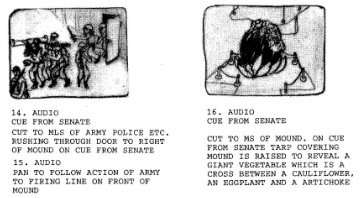
The CD booklet contains a summary of a science fiction plot, with Uncle Meat being the main character. Above are its first paragraph
and two examples of sketches of scenes. It has no connection with the eventual Uncle Meat movie.
2.4-9 King Kong (1969)
The "Uncle Meat" album ends with 16-minute jazz piece called
"King Kong". It has a short composed opening theme and next allows the members of the band to improvise (the subdivision of the title
into a series of six tracks refers to who are playing/soloing in a particular section).
Such improvised sections were an important part of Zappa's live performances, which we can hear on the bootlegs
from this period and the later official live recordings. "King Kong" was included in most of the tours and we can
listen to other improvisations on "Ahead of their time", "What you can't do on stage anymore, vol. 3" and
"Make a jazz noise here".
The next comment on "King Kong" stems from Wolfgang Ludwig's study, pages 134-5, published in 1992.
The "King Kong" theme consists of sets of sequences and variations on motifs in E flat
Dorian (the bass is giving a pedal point on E flat). The melody uses this scale either
in a pentatonic order or in the normal following order. The following example is the opening sequence of the melody.
King Kong, score version, opening bars (midi file).
King Kong, score version, opening bars (notes).
The literal quote goes as: "The melodic sequence [in bars 1-4] is based upon a repetition of motifs, that shows itself first
as a section from a downwardly played pentatonic scale (bars 1-2 without an F), next as a part of the Eb Dorian scale (see
the C in bars 3-4). The Eb tonality manifests itself by an ongoing bass riff of two bars [Ponty plays
the music of Zappa version; on Uncle Meat it's a
plain Eb pedal]. Also in bars 6-12 the pentatonic
colouring of the melody becomes clear; because only in the first and second grade fifth-related notes are used,
Ab, Db, Eb (1st grade) and Gb, Bb (2nd grade). The F and C notes first return again in the next bars. Also
the members of the sequence (bars 1-4) are following the ladder of a downward
pentatonic scale (first notes: Bb, Ab, Gb, Eb)."
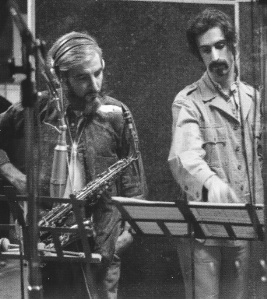 The example above has the King Kong opening as it is indicated in the "Uncle Meat" CD booklet, namely with an Eb pedal and the Absus4 chord.
Something that can be confusing, is that the album version goes different. When you're raised with classical music, you're taught
that the score is sacred. What the score says is what the composer wants, not to be deviated from. In the case of Zappa this is different. Because
of the list below, I've become convinced that his scores are neither blueprints nor ideal versions of how he wanted many of his compositions to sound.
They form a set of versions by themselves, equal in value to the different versions on albums. Zappa could write out sheet music as he does
in the "Uncle Meat" booklet, namely the lead melody with pedal notes and the chords indicated by their symbols. But he could also write out
every detail, not only in the case of orchestra- and chamber music, but also for his rock band. So it can be estranging to see such detailed sheet
music to notice that the first recording of it goes different. Or even that parts aren't included.
The example above has the King Kong opening as it is indicated in the "Uncle Meat" CD booklet, namely with an Eb pedal and the Absus4 chord.
Something that can be confusing, is that the album version goes different. When you're raised with classical music, you're taught
that the score is sacred. What the score says is what the composer wants, not to be deviated from. In the case of Zappa this is different. Because
of the list below, I've become convinced that his scores are neither blueprints nor ideal versions of how he wanted many of his compositions to sound.
They form a set of versions by themselves, equal in value to the different versions on albums. Zappa could write out sheet music as he does
in the "Uncle Meat" booklet, namely the lead melody with pedal notes and the chords indicated by their symbols. But he could also write out
every detail, not only in the case of orchestra- and chamber music, but also for his rock band. So it can be estranging to see such detailed sheet
music to notice that the first recording of it goes different. Or even that parts aren't included.
In the case of "King Kong", the "Uncle Meat" booklet score can be seen as a blueprint. But even so, the indicated Absus4 chord is not actually used on
the "Uncle Meat" album sections that follow below. The first example contains the opening bars, that basically use Absus2, or a plain fifth, instead of Absus4 (in bar 2
the total sounding chord gets extended to an Ab 13th chord). The melody is played over this Absus2 chord in the bass, with the pulsing Eb note in it standing
central. So the opening has something of both Ab Mixolydian and Eb Dorian. The theme itself is notated in a fast 3/8 meter by Zappa. For the accompaniment
you can see that these 3/8 motifs are grouped into larger meters. During the opening 4 times 3/8 becomes 12/8. Most instruments play it
as if it was similar to 4/4, thus to be subdivided into 8 instead of 12, but the drummer is ticking 12/8. In the case of Zappa what the drummer does is decisive
for the meter (something you can note be comparing album versions with the score). When the theme gets repeated it has become 6/8, followed by 12/16. The
pedal note is here plain Eb, where it stays during all of the soloing. Zappa notated the final C of the melody as to be sustained over a number of bars,
so obviously he wanted the accompaniment to fill this in. In the second example below you have a sustained Ebsus4 chord and a progression in staff 3: IV-III-IV-III-IV-III.
The bass line descends from Eb to Bb. Some players repeat the C note, while staff 1 represents an improvised closing melody. The third example is a little outtake
from the solo sections. It has Bunk Gardner playing sax, electronically transformed, while Zappa plays a chord progression. The transformation makes the sound
of the sax unrecognizable, and it gets recorded in the form of parallel octaves. The chord progression by the guitar is, if
I'm not missing some notes, I 7th - II 7th - I 11th - II 7th - I 11th in Eb Dorian. Above to the right Bunk with Frank in the studio, looking at scores
(section of a photo from the Michael Ochs archive as reproduced in the Meat Light booklet).
The theme returns once more in a twisted form
during the outro. The pedal note has shifted from Eb to Db, played by two gongs.
It gets played as if half of it is in Db major, the other half being atonal.
It's deliberately done in this manner. The notes can still be recognized as stemming from the all-diatonic "King Kong" main melody, though full of
dissonants and altered notes (fourth example). The mutation of the sound of standard instruments comes out most strongly in staff 1, with one instrument getting
abnormally high.
King Kong, album version, opening bars (midi file).
King Kong, album version, end of the first statement of the theme (midi file).
King Kong, solo fragment (midi file).
King Kong, outro, opening bars (midi file).
King Kong, album version, opening bars (transcription/notes).
King Kong, album version, end of the first statement of the theme (transcription/notes).
King Kong, solo fragment (transcription).
King Kong, outro, opening bars (transcription).
Other versions of "King Kong", included in this study:
- The "Lumpy gravy" version from 1968 with the melody in 3/8 being played over 4/4.
- The "Prelude to King Kong" has been dealt with above.
- King Kong as played during "Uncle rhebus" gets dealt with in the next section.
- The "Hammersmith Odeon" version from 1978 with the end of the melody and the opening of the guitar solo.
- The "YCDTOSA vol. III" version with a monumental collage of sections from the 1971 and 1982 tours.
- A fragment from the 1988 execution is included in the Make a jazz noise here section, as also "Diplodocus" can be seen as an outtake
from a "King Kong" execution. These sections aren't directly connected to the "King Kong" theme anymore, only the key can be the same.
Both "Uncle Meat" and "King Kong" are examples with Zappa composing lengthy melodies where the harmonization of it is of secondary importance. These melodies
do get harmonized in scores and on albums, but it can be different each time. This is an aspect that makes a number of Zappa pieces sound different from most classical music
and popular music. Normally melody and chords form a unity in Western music. If you would take a Chopin or Debussy piece, distract the lead melody from it and
harmonize it differently anew, it wouldn't sound as Chopin or Debussy any more. But Zappa's music is very flexible as it comes to this. He could put pedal notes
and chords beneath his melodies almost at will. Next is a list of the examples in this study of how the score and an album version can differ (next to the numerous
differences between album versions among themselves):
- "Arabesque/Toad of the short forest". The harmonies of specifically theme 2 are on paper different from the CD.
- "Brown shoes don't make it". The score in the Songbook from 1973 is closer to the 1981 version on "Tinsel town rebellion" than to the one on "Absolutely free".
- "Uncle Meat". The score from both the Songbook and the album liner notes don't include the counterpoint figure from above. It's more than harmonic fill-in.
If you play it with and without it, the difference is decisive for making the opening of the "Uncle Meat" album version sound as it is.
- "Kung Fu". The piano part is not included on "The lost episodes"
- "Nun suit". Album and score go different in many aspects.
- "The girl's dream". The album version and the score differ substantially.
- "Little green scratchy sweaters & courduroy ponce". The rhythm of bar 4 goes different on the album.
- "200 Motels - the suites" is at various points a revised version of the original score. See the 200 Motels section for the details.
- "Big swifty". The piano part is not included on "Waka Jawaka".
- "For Calvin". The album and the score start with different harmonizations.
- "Think it over". The keyboard part is not included on "Joe's domage".
- "The new brown clouds (1972)". Some differences are pointed at in the Wazoo section of this study.
- "Variant I". The guitar part is not included on "Wazoo".
- "Farther O'blivion". The piano part is not included on "Imaginary diseases".
- "Rollo interior". The indicated 2-chords are not played on "Apostrophe (')".
- "Little dots". The trumpet part from the CD inner sleeve is not played like that on this CD.
- "Dupree's paradise" (1974). The piano part is not included on "YCDTOSA Vol. II".
- "This town is a sealed tuna sandwich". As indicated in the Orchestral favorites section below the example, the album and score version differ in many details.
- "Greggery Peccary". The keyboard and trombone parts aren't present on the album in full.
- "Music for low budget orchestra". Different versions of the same set of bars exist.
- "RDNZL". The chords from the opening got reduced on album. The structure of this song changed drastically over time.
- "The black page drum solo". The percussion part by Ruth Underwood got overdubbed and isn't part of the score.
- "The black page". The indicated 2-chords are mostly not played on CD versions.
- "Dancin' fool". The score and album version differ.
- "Jumbo go away", interlude. The score was first known as "Number 6", written for a wind quintet. On the album by keyboards, bass and drums in different registers.
- "Mo 'n Herb's vacation". A few parts got skipped.
- "Sad Jane". Some differences get mentioned in the LSO section.
- "The perfect stranger". As indicated in the corresponding section, there are possibly two versions of the score.
- "Naval aviation in art". Some details on album are different (see the notes below the score).
- "Alien orifice". The harmonies of the score and album version go differently.
- "Pound for a brown" (1992). The bass drum beats from the CD aren't present in the score.
- "Get whitey". The "Yellow shark" album version is somewhat reduced.
 A bar in Amsterdam named after the Louie Louie single, Linneausstraat 11, the song Zappa referred to frequently. The type of houses on the photo
belongs to the 19th century zone (photo downloaded, photographer not mentioned). During 1870-1900 Amsterdam doubled in size
as a consequence of the industrial revolution. Various quarters with houses like this were quickly built, comparable to the immigrant houses in New York.
During the seventies of the previous century city renewal planmakers got the idea to demolish the whole lot of it, to have it replaced by modern appartment buildings.
The eastern part, where Louie Louie stands, suffered the most from this. About 80% of the original houses are lost. Reason for me to write about
a book about the western 19th century district. In this century this demolition wave has stopped. The southern quarters are the best preserved part, quite popular
today, with 80% of the original houses being present. The street views of these quarters are unique. In Holland only Amsterdam has these type of houses
with five stories.
A bar in Amsterdam named after the Louie Louie single, Linneausstraat 11, the song Zappa referred to frequently. The type of houses on the photo
belongs to the 19th century zone (photo downloaded, photographer not mentioned). During 1870-1900 Amsterdam doubled in size
as a consequence of the industrial revolution. Various quarters with houses like this were quickly built, comparable to the immigrant houses in New York.
During the seventies of the previous century city renewal planmakers got the idea to demolish the whole lot of it, to have it replaced by modern appartment buildings.
The eastern part, where Louie Louie stands, suffered the most from this. About 80% of the original houses are lost. Reason for me to write about
a book about the western 19th century district. In this century this demolition wave has stopped. The southern quarters are the best preserved part, quite popular
today, with 80% of the original houses being present. The street views of these quarters are unique. In Holland only Amsterdam has these type of houses
with five stories.
